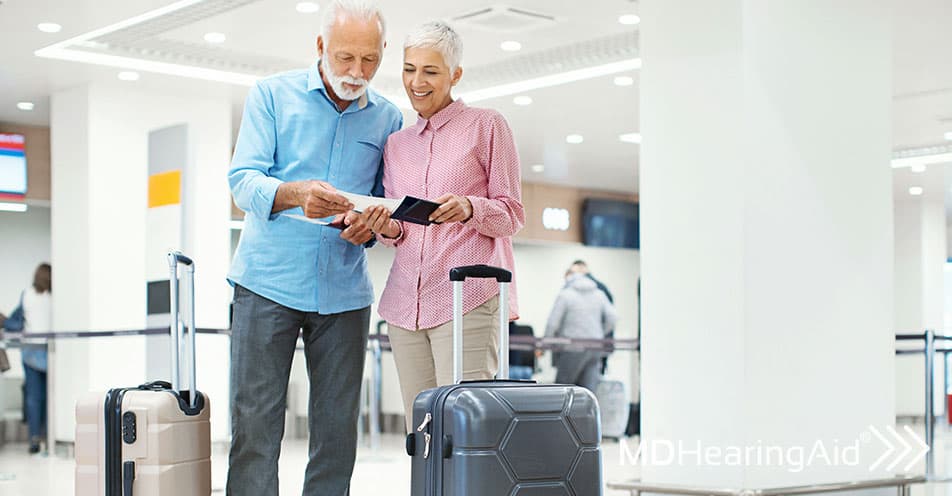As travel disruptions caused by the COVID-19 pandemic continue to lessen, more and more people are planning to get back on the road or in the sky.
According to the State of the American Traveler report, a majority of Americans traveled this summer: between May and August 2022, 62 percent made one or more overnight trips. What’s more, the report found that 88 percent of Americans have current plans for travel, and 80 percent say that they have “high levels of excitement” for their upcoming trip.
If you’re one of the many Americans with future travel plans, you might be worried about traveling with hearing aids. Fortunately, travel with hearing aids—whether by plane, car, or public transport—doesn’t have to be complicated. In this article, we’ll give you some tips and tricks to prepare for travel with hearing aids.
Before You Travel with Hearing Aids
Along with your passport, wallet, and extra sunscreen, your packing checklist should include the essentials for traveling with hearing aids. Below is our guidance about what to bring:
- Of course, bring the hearing aids themselves, as well as a spare set if possible. Having a backup pair available will give you peace of mind in case anything goes wrong with the main set.
- Non-rechargeable hearing aid users should bring a healthy stock of batteries—more than you think you’ll need. For rechargeable hearing aids, bring the charger and a backup charger if you have one.
- Extra hearing aid supplies such as tubing, tips, and domes are always a good idea to bring. If one of these parts malfunctions during your trip, you can easily swap it with a replacement.
- If you’re traveling somewhere humid, or will be near the water, a hearing aid dehumidifier is essential to keep your devices dry and in working order.
- A protective case will securely store your hearing aids when you’re not wearing them (e.g. when you’re showering, swimming, or sleeping).
- Last but not least, a cleaning tool is an essential hearing aid accessory for keeping your devices clear of dirt and debris. Although you’re on vacation, regular cleaning is important so that you can continue to enjoy high-quality sound.
If you’re traveling with hearing aids by air, we recommend keeping these items in your carry-on luggage, not your checked bags. This will ensure that you have everything you need with you throughout your voyage.
Plane Travel with Hearing Aids
For people with hearing loss, traveling with hearing aids by air can seem especially intimidating. The good news is that flying with hearing aids is usually a worry-free experience. Here are our tips for air travel with hearing aids:
- You don’t need to take off your hearing aids when going through airport security. The TSA website states that “you are not required to remove any hearing aids or cochlear implants.” However, TSA officers reserve the right to perform additional screening if the device triggers an alert from their machines.
- Keep your hearing aids on whenever possible, so that you can continue to hear important announcements (e.g. gate changes or instructions from flight attendants and pilots). Avoid the temptation to completely turn off your hearing aids while in flight, even with engine noise and crying babies. Instead, use your device’s noise reduction feature.
- Unlike larger electronic devices such as laptops and smartphones, hearing aids do not have to be switched off at any point during the flight. Some hearing aids come with a flight mode option that temporarily disables the wireless features.
- If you believe that hearing issues may pose difficulties during your travel, be sure to inform people such as airline personnel, TSA officers, and flight attendants.
- Many airports have hearing loop technology, allowing you to connect directly to the public address system if your hearing aids are equipped with a telecoil. Check if the airports you’ll be visiting have this technology available, or look for the induction loop symbol (an ear with the letter T).
Other Methods of Travel with Hearing Aids
If you’re instead going by car, train, or public transport, here are some tips for traveling with hearing aids:
- Drivers with hearing aids should wear them in the car so that they can hear important cues from their environment. To reduce noise, roll up the windows and turn down or turn off the radio speakers. If you’re fatigued or having trouble focusing, switch drivers.
- Like airports, many train stations and public transit systems now offer hearing loop systems. Check ahead of time to see if you can use this technology while en route.
- Take advantage of any discounts available for travelers with hearing loss. For example, Amtrak offers a 10 percent discount to passengers with disabilities.
Regardless of your method of transport, you should know your rights under the U.S. Americans with Disabilities Act (ADA) and the Air Carrier Access Act (ACAA). The ACAA prohibits any airlines operating in the U.S. from discriminating against passengers with physical or mental disabilities.
Traveling with hearing aids should be enjoyable, not stressful. By planning ahead, you’ll be much more likely to make your upcoming travel with hearing aids a smooth, pleasant experience.
Are you planning on taking a trip? Stock up on all of your hearing aid necessities before you go!
BROWSE THE MDHEARING STORE

